Effective communication is the backbone of a smooth-running manufacturing operation. Without it, communication breakdowns accumulate, production falls, and team morale suffers in the industrial industry. On the other hand, clear and consistent communication ensures that everyone is on the same page, minimizing mistakes, improving efficiency, and creating a safer workplace environment.
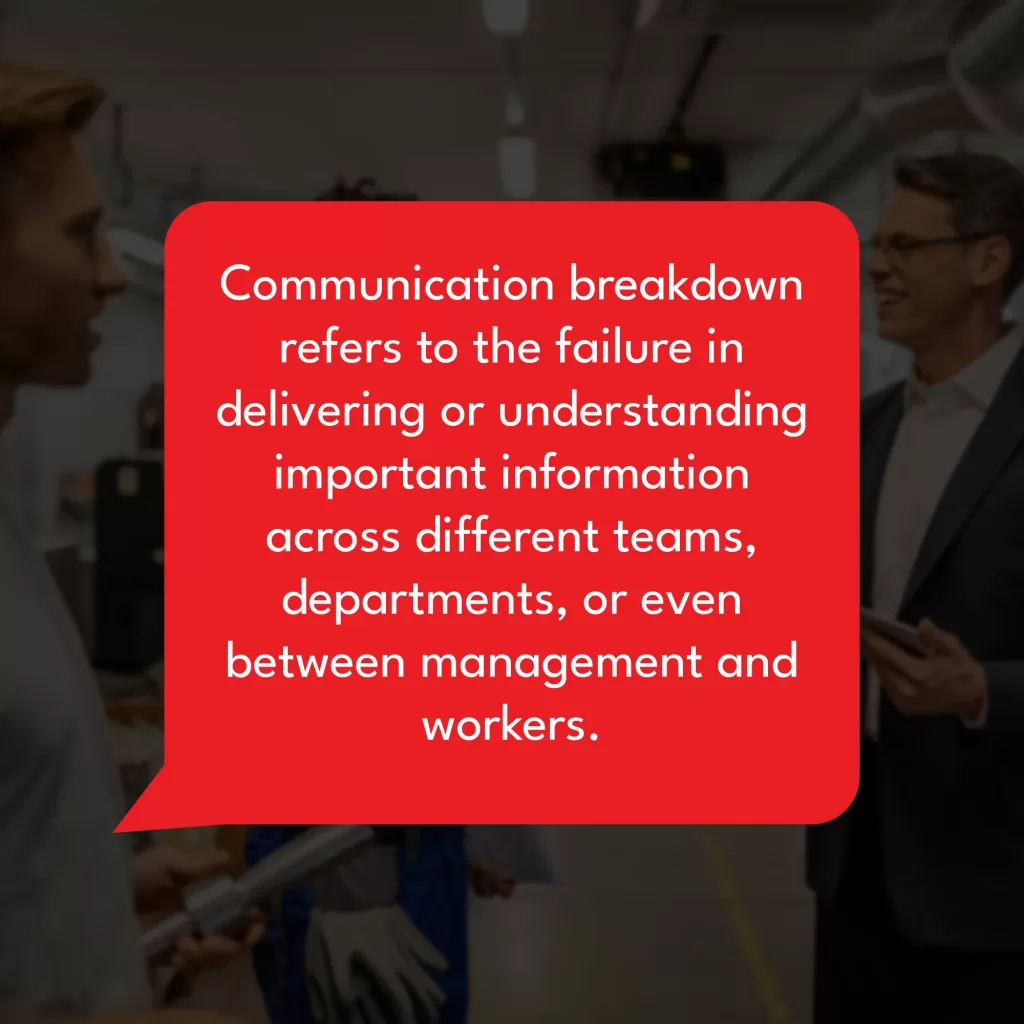
However, communication in the manufacturing industry faces its unique set of challenges. Whether it’s the use of outdated communication systems, language barriers between workers, or the physical distance between departments, these issues can severely disrupt workflow. It is therefore essential to work on communication breakdowns as well as address these challenges to ensure smooth operations and achieve production goals in the Manufacturing Industry.
Common Communication Breakdown Pain Points in Manufacturing
When communication breaks down, even small missteps can cause significant disruptions In the manufacturing industry. From delayed production schedules to safety hazards, the consequences are far-reaching. Especially, miscommunication can be challenging in an environment where teams need to stay aligned and operations must run smoothly.
So, what are the most common communication pain points that manufacturing teams face? Let’s break it down:
Misaligned Production Schedules
When production schedules aren’t properly communicated or updated across departments, chaos can ensue. How? Suppose, the production team is unaware of a change in demand from the sales department. If production continues at the initial volume, the factory may end up overproducing items that aren’t needed, leading to wasted materials and storage issues. On the flip side, if production decreases due to a miscommunication, you risk under-delivering to customers. This leads to missed deadlines and lost business. So, clear and consistent updates are crucial to avoid these costly errors.
Inefficient Workflow and Coordination
Manufacturing workflows often involve several departments working together, such as design, procurement, production, and shipping. When communication between these departments is weak or unclear, coordination issues can occur. That can cause bottlenecks in the process as well. For instance, the production team may be waiting on raw materials that procurement thought were already ordered.
Inaccurate Information Sharing Across Teams
When teams don’t share accurate information, small errors quickly grow. For example, if the inventory team provides the wrong stock levels, the production team may start work assuming they have everything. Halfway through, they may discover key materials are missing. This disrupts schedules and causes delays. Such communication breakdowns are common in the manufacturing industry and can halt operations altogether.
Safety Risks Due to Poor Communication
Manufacturing environments are full of hazards, and safety procedures must be communicated to ensure worker protection. This not only puts employees at risk but also opens the company up to legal liabilities.

Delayed Decision-Making Processes
Fast decision-making is critical in manufacturing. Because here delays can cause production schedules to slip. When communication is slow or unclear, important decisions—like adjusting production levels or allocating resources—can be delayed. It can impact timelines and even customer satisfaction. Teams that don’t receive timely information will find themselves waiting for approval or updates, further slowing the process.
Poor Shift Handover Communication
In a 24/7 manufacturing operation, shifts overlap, and proper handover communication between outgoing and incoming teams is essential to maintaining productivity and avoiding mistakes. Without a clear handover process, the incoming team may not be aware of equipment issues, production updates, or unresolved problems, leading to wasted time and potential rework.
Supplier and Vendor Miscommunication
Effective communication with suppliers and vendors is also very crucial to keeping the production line running smoothly. Miscommunication can result in delayed or incorrect deliveries, which in turn can halt or slow down production. This can happen if purchase orders are not communicated clearly, or if suppliers are not kept in the loop about changes in demand.

Impact on Employee Morale and Engagement
Communication is key to employee engagement. When team members feel they are kept in the dark or that their concerns are not being addressed, morale plummets, which in turn impacts productivity. Poor communication between management and staff can create a sense of disconnect, leaving employees disengaged and unmotivated.
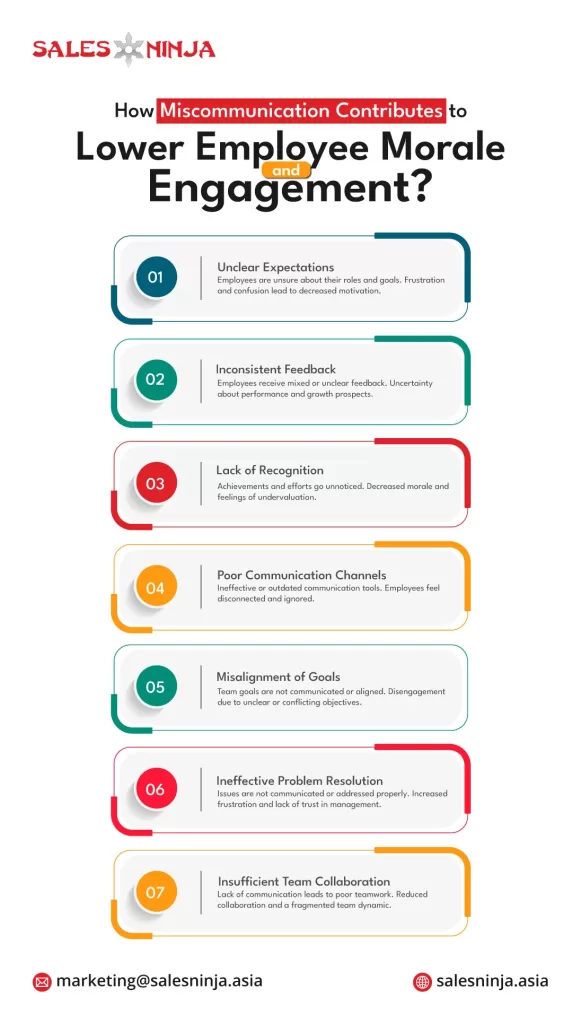
Inconsistent Quality Control Communication
Quality control is a vital aspect of manufacturing. If quality control standards, testing results, or procedures aren’t consistently communicated, the quality of the product can suffer. Teams may use different benchmarks or methods, resulting in inconsistent products or even product recalls.
Technological Integration Challenges
As manufacturing moves toward more automation and digital integration, clear communication about how new technologies will be implemented is crucial. Employees need to understand how to use new systems, and any issues or glitches must be addressed immediately. When communication around these integrations is unclear, it leads to confusion, resistance, and operational delays. For example, if a factory installs a new inventory management system but doesn’t provide adequate training or information to staff. The result will be widespread confusion, and for weeks, workers will revert to the old system, delaying the transition and increasing the chance of errors.
Root Causes of Communication Breakdowns
Communication breakdowns in the manufacturing industry don’t just happen out of the blue. They usually stem from deeper, systemic issues that affect the entire organization. To address these breakdowns effectively, we first need to understand their root causes. Often, the problems go beyond just poor messaging between teams—they can arise from structural and procedural gaps that have become ingrained over time. Let’s explore some of the key causes behind these breakdowns.
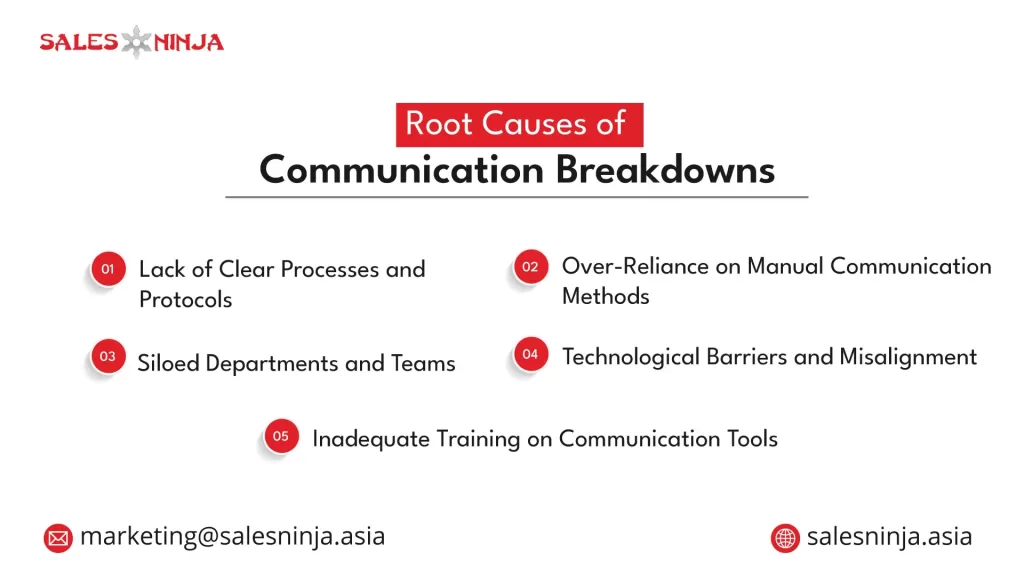
Lack of Clear Processes and Protocols
Without well-defined processes for communication, it’s easy for messages to get lost or misunderstood. In manufacturing, where many moving parts rely on accurate and timely communication, the absence of clear protocols can create confusion. For example, if there’s no set procedure for reporting machine maintenance issues, one department may assume another is handling it, leading to delays and potential safety risks. Establishing standardized protocols ensures that everyone knows how and when to communicate critical information.
Over-reliance on Manual Communication Methods
Manufacturing has traditionally relied on manual communication methods such as paper forms, phone calls, or face-to-face conversations on the factory floor. While these methods may have worked in the past, they are inefficient in today’s fast-paced, digital world. A message left on a sticky note or communicated verbally can easily be forgotten or misunderstood, leading to errors in production or safety incidents. Modern communication tools, like instant messaging platforms and digital dashboards, help streamline these interactions and reduce the chances of something falling through the cracks.
Siloed Departments and Teams
When different teams or departments operate in silos, they tend to focus solely on their own goals without considering the impact on the rest of the organization. In manufacturing, this can mean that the production team might not fully understand the priorities of the sales team, or that procurement may not be on the same page as logistics. This lack of cross-functional communication can create bottlenecks and inefficiencies. Breaking down these silos by encouraging interdepartmental collaboration can significantly improve communication flow and overall operational efficiency.
Technological Barriers and Misalignment
While technology can be a powerful enabler of communication, it can also be a barrier if not properly aligned with business needs. In some manufacturing environments, teams may be using outdated systems or tools that aren’t compatible with one another, leading to delays and confusion. For example, the production floor might be using legacy software while the office staff operates with modern digital tools, making it difficult to share information in real time. Ensuring that communication technologies are integrated and user-friendly is key to overcoming this hurdle.
Inadequate Training in Communication Tools
Even when modern communication tools are in place, they can be ineffective if employees are not properly trained on how to use them. Many organizations invest in sophisticated systems but fail to provide adequate training. In the manufacturing industry, communication breakdowns often stem from this issue. Employees need to understand not only how to use these tools but also why they are important for maintaining efficient communication across the company.

Strategies to Overcome Communication Challenges
Overcoming communication breakdowns in the manufacturing industry requires a strategic approach. These challenges don’t just resolve themselves—they need proactive measures that ensure smooth information flow, better collaboration, and improved decision-making processes. When communication is seamless, operations run more efficiently, safety risks are reduced, and teams feel more aligned. To tackle these challenges, let’s look at some key strategies that can help organizations overcome communication barriers.
Implementing Centralized Communication Tools
One of the most effective ways to prevent communication breakdowns is by implementing a centralized communication system. Instead of relying on fragmented methods like emails, phone calls, or in-person conversations that can easily be forgotten or misunderstood, a single platform where all messages, updates, and project details are stored creates transparency and accessibility. Tools like Slack, Microsoft Teams, or dedicated manufacturing software allow team members to track conversations, share important documents, and quickly resolve issues. This ensures everyone is on the same page, reducing miscommunication across departments.
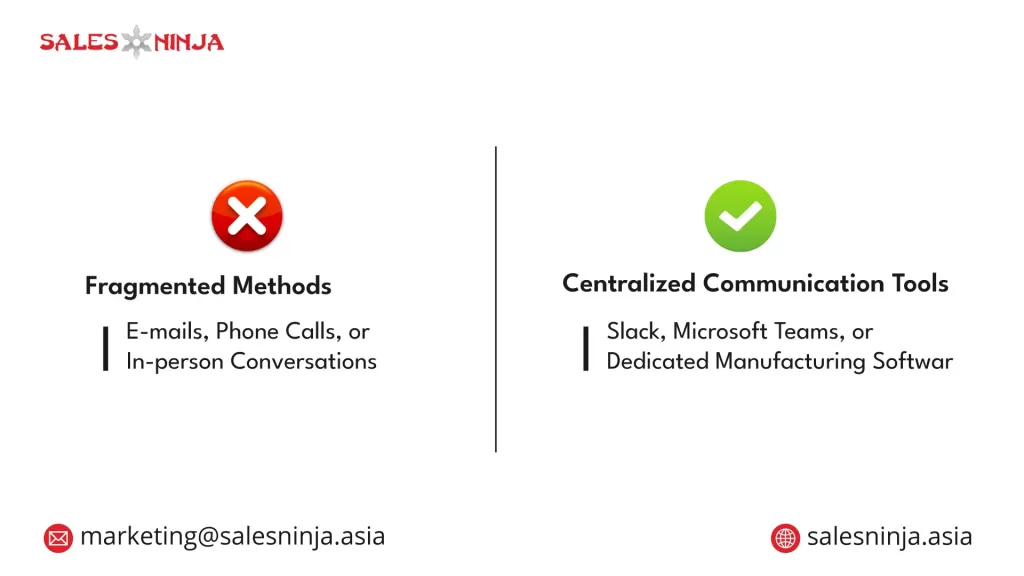
Improving Cross-Department Collaboration
When departments work in silos, communication can easily break down, leading to inefficiencies in the manufacturing industry. Improving cross-department collaboration can help bridge gaps between teams. For example, regular meetings between production, procurement, and quality control can foster better understanding and alignment on shared goals. When departments openly communicate and understand how their work impacts others, it minimizes errors, delays, and the overall misalignment of objectives. Encouraging inter-departmental teamwork strengthens the entire organization.
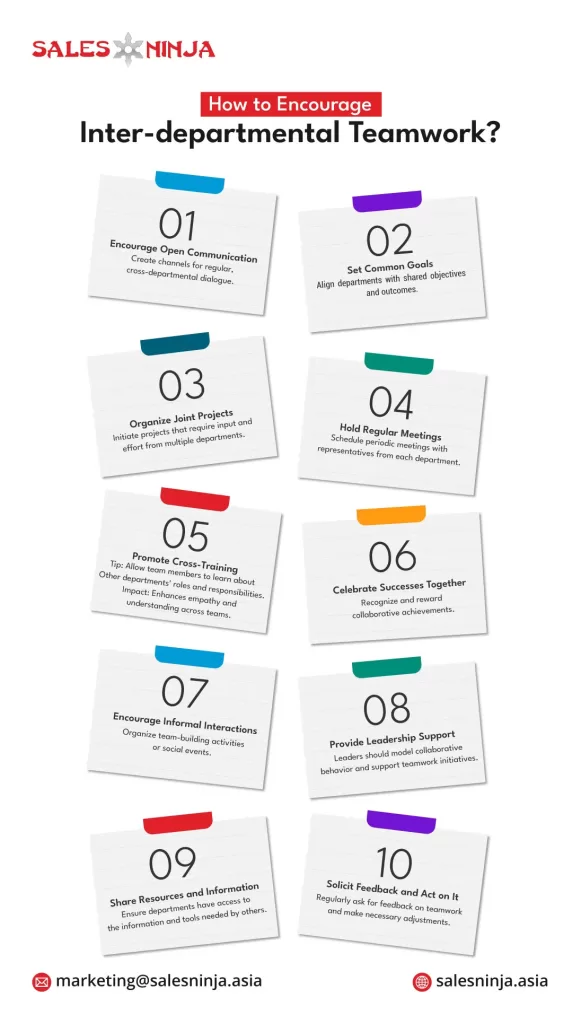
Establishing Clear Communication Protocols
Having clear communication protocols is vital to prevent breakdowns that can disrupt operations in the manufacturing Industry. Clear communication protocols ensure that teams report issues, update project statuses, and inform about safety hazards without overlooking anything. Assign responsibility for relaying information, decide how it will be shared (in writing, via software, or in person), and specify when updates are needed. This removes ambiguity and helps avoid delays caused by uncertain processes.
Enhancing Safety Communication Practices
In manufacturing, safety is paramount, and clear communication is critical to preventing accidents. Regular safety briefings, visual cues on the production floor, and open reporting of potential hazards can enhance safety communication practices. Implementing digital systems that track safety reports and enable workers to alert their supervisors about risks in real-time can help prevent accidents before they happen. Prioritizing safety communication shows workers that their well-being is valued, fostering a safer and more trusting work environment.
Strengthening Shift Handover Procedures
Shift changes can be a vulnerable time for communication breakdowns, especially if critical updates aren’t shared properly. Whether it’s through digital handover notes, checklists, or in-person meetings, making sure there’s a smooth transition between shifts minimizes disruptions and ensures work continues efficiently.
Regular Communication with Suppliers and Vendors
Miscommunication doesn’t just happen internally—it can also affect your relationships with suppliers and vendors. Maintaining regular and clear communication with external partners ensures alignment on production timelines, quality expectations, and delivery schedules. Tools like supplier management software can make it easier to track orders and flag any potential issues before they escalate into larger problems.

Fostering a Culture of Open Communication
Creating a culture where employees feel comfortable sharing feedback and ideas can significantly improve overall communication. Valuing workers’ voices encourages them to share important insights that can prevent errors or improve processes. Encouraging open communication through regular team meetings, anonymous suggestion boxes, or an open-door policy with leadership helps employees feel engaged and empowered to contribute to the company’s success.
Technological Solutions for Better Communication
Communication challenges in manufacturing often stem from outdated processes and the complexity of coordinating multiple teams, machines, and suppliers.. Technology can be a powerful ally in solving these issues, streamlining the flow of information, and making operations more efficient. By embracing the right technological tools, manufacturers create a smoother communication environment where data flows seamlessly, enabling quicker and more accurate decision-making. Let’s explore some of the key technological solutions that can significantly contribute to communication breakdowns in the manufacturing industry.
Manufacturing Communication Platforms
A centralized communication platform is a game-changer for manufacturing teams. Platforms designed specifically for the industry, like Tulip or PTC, allow for real-time sharing of data, production updates, and collaboration between departments. A dedicated system connects and informs everyone, from the shop floor to the office, eliminating the need to rely on emails or walkie-talkies. And, then the maintenance team can act on it quickly. Consequently, it will help in reducing downtime and avoiding further delays.

Leveraging IoT and Automation for Real-Time Updates
The Internet of Things (IoT) and automation are changing manufacturing communication. They give real-time updates on machines, production lines, and inventory. Sensors in machines and automated systems track production. Managers no longer rely on manual reports or wait for floor feedback. For example, IoT-enabled machines notify supervisors when they need maintenance. Besides, when production thresholds are met, quick actions follow. This real-time communication improves decisions and cuts delays from waiting on manual reports.
Integration of ERP Systems for Streamlined Communication
Enterprise Resource Planning (ERP) systems, like SAP or Oracle, are essential for manufacturers who want to streamline communication across various functions. ERP systems act as a central hub for all business processes. From procurement to production to sales, it ensures that everyone has access to the same accurate data. Integrating these systems allows teams to easily track inventory, monitor production schedules, and manage supply chain logistics, reducing the risk of miscommunication. For example, if a production manager notices a delay in raw materials, they can check the ERP system to see exactly where the issue lies. Whether with procurement, a supplier, or shipping—it allows us to address the problem quickly and avoid any surprises.
Training and Employee Engagement
Effective communication in the manufacturing industry doesn’t just rely on tools and technology. It also depends on the people behind the scenes. Employees are the heart of any manufacturing operation. And, how well they communicate can directly impact productivity, safety, and overall performance. However, training and engagement are essential to ensure that communication flows smoothly across teams.
Equipping employees with the right skills and encouraging them to take ownership of communication streamlines the entire process. Let’s look closely at some key strategies to strengthen communication through training and engagement.

Providing Communication Skills Training
Communication skills training is one of the best ways to improve communication in a manufacturing environment. This goes beyond simple conversations. It teaches employees how to share information, listen well, and adjust their communication style for different situations. For instance, workers on the production line may need to report urgent safety issues to managers. Engineers might have to explain complex machinery problems to non-technical staff. By offering training that covers these situations, you ensure everyone can convey information effectively, reducing the chances of miscommunication.
Button: Get Training in Communication Skills
Encouraging Team-Building for Better Collaboration
A well-connected team communicates better. And team-building activities can play a crucial role in fostering collaboration. In the manufacturing industry, where different departments often operate in silos, it’s essential to create opportunities for teams to bond and break down barriers. Simple team-building activities, like cross-department meetings or problem-solving workshops, can help employees understand each other’s roles and perspectives.
Sign Up For The Best Team-Building Training
For example, a workshop that brings together the production and quality control teams can help both sides appreciate how their communication impacts the final product. This leads to smoother coordination on the floor.
Building Strong Teams In A Hybrid Work World
Empowering Employees to Take Ownership of Communication
When employees feel empowered, they take responsibility for communication. This leads to more active engagement and speaking up when needed. It starts by fostering a culture that values open dialogue. Encourage staff to share ideas, raise concerns, or offer feedback without fear. For example, a worker noticing an inefficiency on the production line should feel confident to suggest improvements. They should highlight issues to supervisors without hesitation. By creating a space where communication is a shared responsibility, manufacturers ensure information flows freely at all levels.
Strengthening Communication for Long-Term Success
Overcoming communication breakdowns in the manufacturing industry isn’t just about solving immediate issues—it’s about laying the foundation for long-term success. Smooth communication improves teamwork, accelerates decision-making, and minimizes potential risks. Moreover, as technology continues to evolve, staying ahead of communication trends, such as real-time data sharing and the integration of automation tools, will be crucial for maintaining a competitive edge.
Sales Ninja offers a variety of training programs designed to assist teams develop the communication skills required to survive in today’s fast-paced industrial environment. You can look them up on our website, or you can tailor any training to your specific needs by contacting our training solution manager. Let us work together to build an empowered, connected team capable of facing tomorrow’s challenges.




